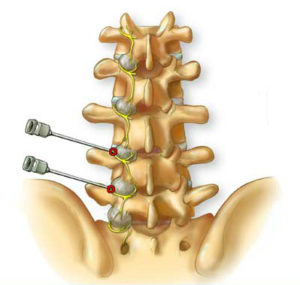Who would benefit from this procedure?
This is typically performed after significant pain relief is achieved from two medical branch blocks for their axial pain.
How does this procedure work?
The medial branch nerves that supply the facet joints are cauterized or lesioned. The denervation of the facet joint results in pain relief.
How is the procedure done?
The patient will lie on his/her abdomen. The skin is first cleaned in proper surgical sterile fashion, skin is than anesthetized for our targets, this is followed by placement of needle under x-ray guidance to its target. After the target is reached intra-operative sensory and motor testing is done to ensure that radicular nerves are not going to be lesioned. This is followed by injection of a local anesthetic (bupivacaine 0.5%) than the lesioning is performed.
Lesioning or nerve ablation is done with heat (80-85 degrees Celsius) for 60-90 seconds. Needles are than re-positioned and a second round of lesioning of 60-90 seconds is done.
After the lesioning than mixture of local anesthetic with steroid is injected for pain relief.
What are the potential risks?
Although this is a very safe procedure, it is not without risk. Whenever a needle is used there is always the risk of infection and bleeding. There is also risk for radicular nerve root lesioning that can result in sensory pain or weakness, however this risk is minimized with x-ray guided needle placement and intra-operative testing prior to lesioning that we perform in our office.
What should I expect after the procedure?
It is normal to experience temporary soreness at the need placement sites. Some patient can experience a burning sensation at lesioning sites. However, this is temporary and typically lasts 3-7 days. This can be treated by taking your pain medications and applying ICE to the site. This should be followed by 6 or more moths of pain relief improvement.

